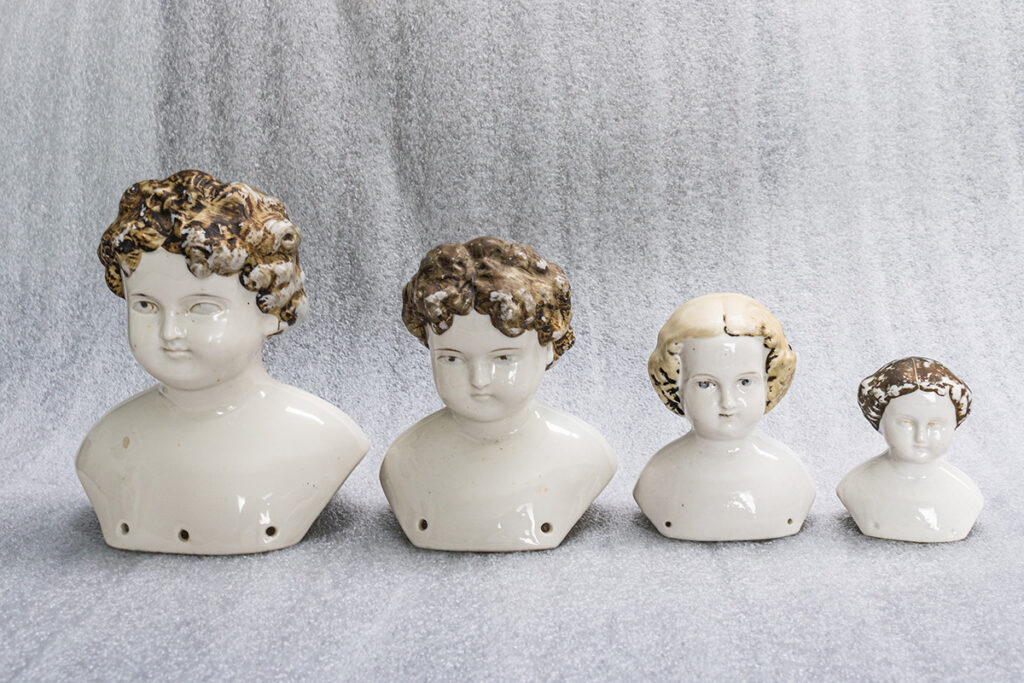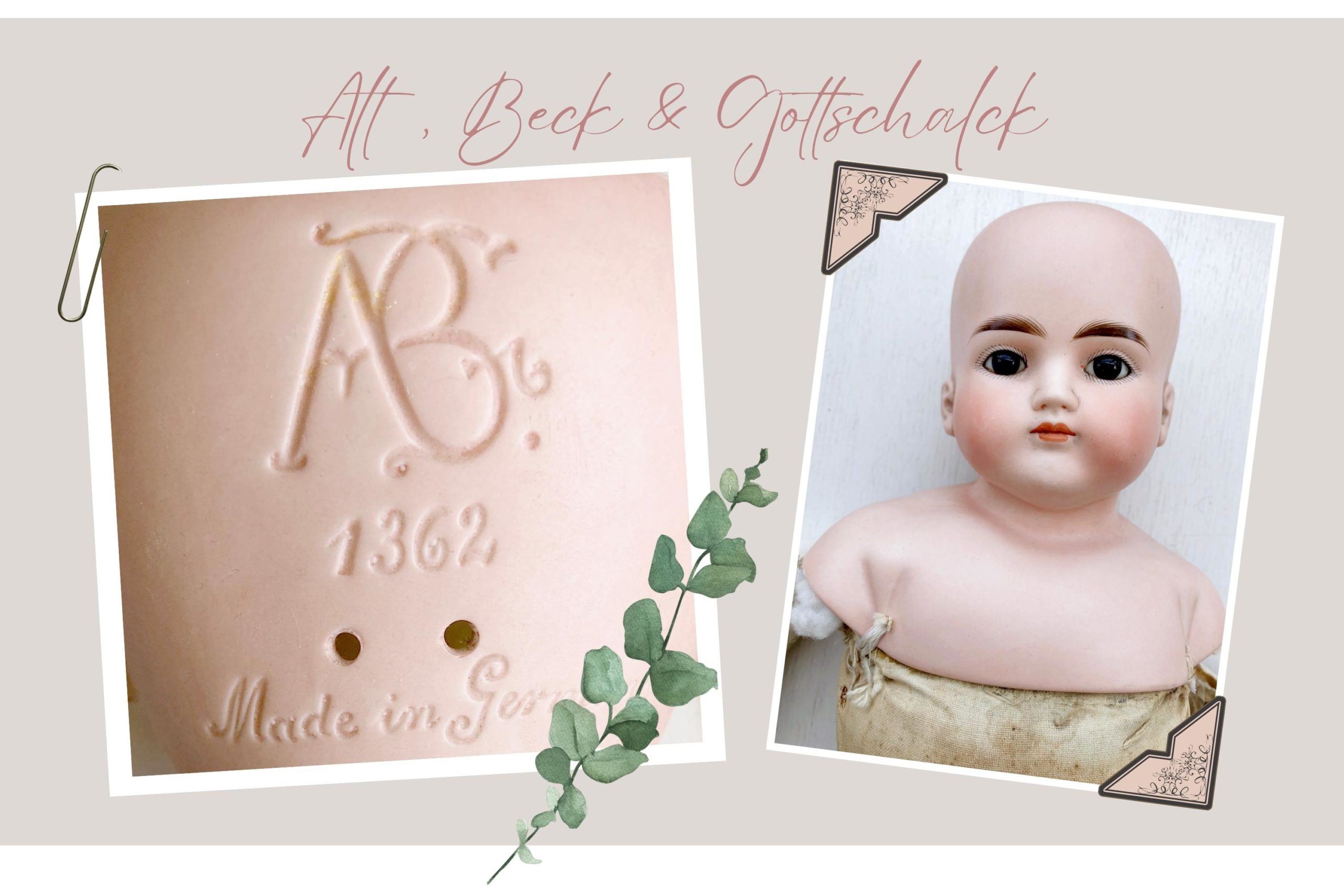The Alt, Beck & Gottschalck advertised they existed since 1853. The company manufactured both child and lady dolls with cloth and kid leather stuffed bodies as well as jointed compositions. They are known for their beautiful china and parian doll heads.
1866 Sachsen-Coburg-Gotha, Statistisches Bureau:
A statistics book from 1866 for the areas of Sachsen, Coburg, and Gotha mentions the third factory of “Alt, Beck, Gottschalck and Wiesenthal” near Stutzhaus. (Saxe-Coburg-Gotha, Statistical Bureau: Information from the Statistical Bureau of the Ducal State Ministry in Gotha. 1866)
1878 Claim by Krombholz about ABG Doll Heads
Mary Gorham Krombholz wrote in her book “A Pictorial Reference Guide for German Chinas” that the 1878 ruins of a steamship called “The City of Houston” included shoulder heads with curly child hairstyles by Alt, Beck and Gottschalck. These had hairstyles similar to ABG doll heads dated from the 1880s. She does not state her sources to verify this claim.
In 1987 divers found ceramic bottles, slates, medicine bottles, marbles, porcelain china dolls, wood farm animals, building blocks, tin soldiers, and household items like silverware, bottles of drugstore stock, snuff, sewing machines. The maritime museum in Southport, North Carolina had some of the ruins on display in the past. One of the divers, Wayne Strickland of Southport, donated four of the doll heads found to the Maritime Museum in Southport. None of the four doll heads Mr. Strickland donated has a curly childlike hair style. Two of his doll heads have a Dolly Madison hairstyle, and the other two have flat top styles contributed to the 1860s.

1880 Johann Georg Wilhelm Alt.
Johann Georg Wilhelm Alt, factory owner in Ohrdruf, receives the title of “Commerzienrath” or Kommerzienrat by the duke in 1880.
1882 French Annual Almanac Listing
One can find the Gottschalk et Cie listed in Frances’ Annual Almanac of Commerce. The listing falls under a category of businesses manufacturing bisque. It reads, “GOTTSCHALK ET CIE, representative. of (apr. of children’s toys, from Germany, notably from Nuremberg, Saxony, Tyrol, etc., glass and porcelain balls from Lauscha (Saxony), ordinary and unbreakable babies, lead articles, basketry, Faub.-StMartin , 76”
1893 World’s Columbian Exposition in Chicago
Alt, Beck & Gottschalck advertise for the 1893 World Columbian Exposition they are a porcelain manufacturer in Nauendorf near Ohrdruf in Thuringia making doll-heads, china dolls, Chinese dolls, figures and animals. At the exposition they joined with others as part of a collective exhibit of the “Toy Industry of Gotha-Waltershausen, Ohrdruf” with Emil Wittzack of Gotha as the business manager. The Chicago Commercial Company represented the collective group at the exposition (World’s Columbian Exposition: Chicago – Official Catalogue Exhibition of the German Empire; Berlin: Imperial Commision. 1893).

1896 Reference to ABG in the Thuringian Handbook
A listing in the 1896 geographic handbook to the Thuringian area tells about the company of Alt, Beck & Gottschalck. The listing reads that Alt, Beck & Gottschalck is a porcelain factory in Nauendorf making doll heads and porcelain toys. The factory’s novelty are described as “bisque doll heads, then porcelain toys, later also utility and fancy articles: eggs, stands, bowls, porcelain children, bisque angels, animal figures.”
The listing claims Alt, Beck & Gottschalck two “porcelain turners” from Ohrdruf founded the company in 1853. In 1863 the company then called Wiesenthal, Gottschalck & Ko. also owned the factory in Stutzhaus. The handbook claims the factories had 5 large kilns and 3 mass mills. About 300 workers in both factories together and more than 100 families working outside the factory.
(Regel, Fritz. Thuringian: a Geographic Handbook. Jena: Fischer. 1896)
1902
Porzellanfabrik Unterweißbach, formerly Mann and Porzelius, A.-G. to Unterweißbach. The annual report describes the business year that ended on December 31, 1901 as a good one. Apart from the minor normal additions, the additions to the individual accounts result from the transfer of the previous year’s new construction account to the building account and from the takeover of the oldest Volksstadt porcelain factory, formerly Triebner, A.-G. Volkstedt near Rudolstadt. (Allgemeine Zeitung. March 1, 1902, p. 20)
1906 Address Book of the Ceramic Industry
In 1906 they advertised Alt, Beck & Gottschalck employed about 300 workers at their porcelain factory in Nauendorf near Ohrdruf. The listing says they made toys and figurines while specializing in making doll heads for export as well as nanking dolls, sacred articles, figurines, bathing babies, animals, votive cauldrons, and knick knacks. (Adressbuch der Keramischen Industrie, Coburg: A. Rossteutscher, 1906, p. 2).
In 1906 the owner and managing director listed was “Reinh., Wilh., and Ernst Weingart.” They claimed to have representatives in Hamburg, Paris, Berlin, and Brussels. (Reinh. stood for Reinhold and Wilh. stood for Wilhelm.)
(NOTE: By the way, if you are wondering, “nanking dolls” referred to dolls with cotton cloth bodies made of a pale yellowish cotton cloth sometimes called “nankeen” originally made in Nanjing, China. Nanjing – Nanking)
1909 Ernst Weingart and Carl Pohlmann
The magazine for porcelain manufacturers shows a listing in 1909 for Alt, Beck & Gottschalck. In 1909 the managing directors listed were businessman Ernst Weingart, Nauendorf, and businessman Carl Pohlmann, Steglitz. The company had a share capital amount of 100,000 marks.
“The object of the company is the acquisition and continuation of the porcelain factories in Nauendorf near Ohrdruf previously operated by the limited partnership Alt, Beck & Gottschalck in Nauendorf, in particular the manufacture, decoration and sale of porcelain goods of all kinds and the conclusion of all legal transactions associated with them, insofar as they appear to be useful for achieving the company’s purposes.” (Sprechsaal. Coburg, Germany: Müller and Schmidt,1909)
1915 Alt, Beck & Gottschalck Patents
The German magazine for porcelain manufacturers, Sprechsaal, announces two patent registrations for tool designs by Alt, Beck & Gottschalck in 1915. Patent 629,003 was a design for a device for inserting movable eyes into doll heads. Patent 629,013 was for a device for inserting movable sleeping eyes and movable tongues into a doll heads by means of a frame made of one piece. (Sprechsaal, Coburg: Muller & Schmidt. 1915.)
1918 ABG Events
Patent Extension
Their patent for a device used to insert movable eyes into a doll head got a protected extension in 1918.
Association of Germany Luxury Porcelain
Alt, Beck and Gottschalck are listed among “Members of the Association of German Luxury Porcelain Factories” (Keramische Rundschau, 1918)
Alt, Beck & Gottschalck G.m.b. H.
The business communications in an official newspaper made an announcement of a merger in 1918 regarding the acquisition of shares in Alt, Beck & Gottschalck G.m.b. H. in Nauendorf near Ohrdruf. The focus of the merger was with Richard Eckert & Co. A. – G. in Volkstedt. (Sprechsaal. Coburg, Germany: Muller & Schmidt. 1918. p. 184).
Alt, Beck & Gottschalck Doll Marks
Many early doll heads by Alt, Beck & Gottschalck may not have any markings or only a number. Some shoulderheads have a number on the lower left side of the shoulder plate usually covered by the kid leather. Once uncovered the numbers can be matched with what is known. The numbers were followed sometimes by the scripted words “made in Germany” or “Germany” and the letter N for number. Sometimes “No” before the size number is found.
Later on they created a trademark. with the combination of the letters ABG.

See more about other German antique dolls here.
To know more about identifying antique dolls click here.
